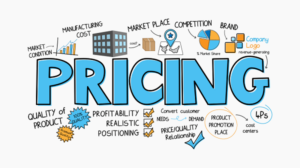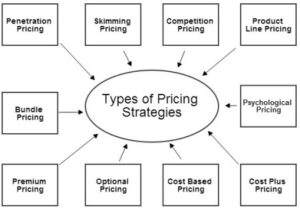Pricing is a delicate balancing act. Set your prices too high, and you risk scaring off customers who are looking for a better deal. Set them too low, and you may sacrifice your profit margins, leaving your business vulnerable to financial instability. But get it just right, and you can unlock revenue, driving your business towards success and profitability.

The art of pricing is a nuanced one, influenced by a complex array of factors, from production costs and market demand, to customer psychology and competitor analysis. In this guide, we’ll explore the world of pricing strategy, providing you with the expert insights and practical tools you need to price your ecommerce products for maximum returns. Whether you’re a seasoned entrepreneur or just starting out, this guide will help you navigate the complexities of pricing, and unlock the full potential of your online store.
Step 1: understand your costs
Before you can determine your selling price, you need a clear picture of all your product-related costs. Here’s a breakdown of the key factors to consider:
- Product cost: This includes the cost of acquiring your product, whether it’s manufactured in-house, sourced from a wholesaler, or dropshipped.
- Landing cost: Factor in any additional costs incurred to get the product to your warehouse, like shipping fees, customs duties, or import taxes.
- Storage costs: Account for the cost of storing your inventory, whether it’s in a rented warehouse or your own space (rent, utilities, etc.).
- Packaging costs: Include the cost of materials like boxes, tape, labels, and any custom packaging you may use.
- Fulfillment costs: If you’re not dropshipping, factor in the cost of picking, packing, and shipping each order.
Step 2: Factor in additional expenses
- Marketing & advertising costs: Consider the cost of attracting customers through online ads, social media marketing, or other promotional efforts.
- Payment processing fees: Account for the fees charged by payment processors like Stripe or PayPal for each transaction.
- Website maintenance fees: Include the cost of maintaining your online store platform, domain name hosting, and any security software subscriptions.
Step 3: Identify your profit margin goals
Your profit margin is the difference between your selling price and your total costs. Here are some factors to consider when setting your target profit margin:
- Industry standards: Research the average profit margin for your industry to get a baseline.
- Product value: Higher-quality or unique products can often command a higher profit margin.
- Competition: Analyze your competitors’ pricing to gauge customer expectations and identify potential gaps in the market.
- Business goals: Are you prioritizing rapid growth (lower margins) or maximizing profitability (higher margins)?
Step 4: Explore different pricing strategies

Once you understand your costs and profit goals, you can choose a pricing strategy that aligns with your business objectives. Here are some common approaches:
- Cost-Plus pricing: Add a markup percentage to your total product cost to arrive at your selling price. This is a straightforward method, but may not account for market demand.
- Competitive pricing: Set your prices based on what your competitors are charging for similar products. This can be helpful for new businesses, but doesn’t leverage your unique selling proposition.
- Value-based pricing: Determine the perceived value your product offers to customers and price accordingly. This strategy can command higher margins if your product solves a specific problem or offers unique benefits.
- Premium pricing: Price your products at a higher-than-average range to position them as luxury or exclusive items. This works well for high-quality, brand-name products.
- Penetration pricing: Offer a lower introductory price to attract new customers and gain market share. This can be a good tactic for launching new products.
Step 5: Consider psychological pricing
Psychological pricing leverages consumer behavior to influence purchase decisions. Here are some tactics to explore:
- Charm pricing: Ending prices in “.99” creates a perception of a lower price point.
- Price anchoring: Highlight a higher price initially, then present your actual selling price as a discounted offer.
- Bundling: Offer discounted pricing when customers purchase multiple products together.
Step 6: Monitor and refine
Pricing is an ongoing process. Track your sales data and customer behavior to see how your pricing strategy is performing. Be willing to adjust your prices based on market trends, competitor activity, and your own profitability goals.
Additional tips for ecommerce product pricing:
- Offer tiered pricing: Provide discounts for bulk purchases to incentivize larger orders.
- Implement dynamic pricing: Adjust prices based on factors like demand, seasonality, or competitor pricing (requires advanced tools).
- Test different pricing strategies: Run A/B tests to see how customers respond to different price points.
- Clearly communicate your value proposition: Explain to customers why your products are worth the price you’re charging.
Tools and resources for ecommerce pricing success
Having mastered the foundational principles of ecommerce pricing, it’s time to take your strategy to the next level. This section equips you with valuable tools and resources designed to streamline the process, elevate your approach, and unlock the full potential of effective pricing for your online business. Here are some valuable tools and resources to elevate your pricing strategy:
- Pricing software: Consider using software specifically designed for ecommerce pricing. These tools can help you calculate costs, factor in competitor pricing, and even suggest optimal price points based on your profit margin goals. Some popular options include:
- PriceLabs (https://hello.pricelabs.co/)
- ProfitWell (https://www.saasworthy.com/product/profitwell/pricing)
- Zpricing (https://www.zpricing.com/)
- Competitive pricing research tools: Tools like Amazon Price Tracker (https://m.youtube.com/watch?v=ZFcqJVBjSoI) or PriceMole (https://pricemole.io/) allow you to monitor competitor pricing fluctuations and identify potential gaps in the market where you can position your products strategically.
- Market research resources: Leverage market research reports and industry publications to stay informed about pricing trends within your niche. Websites like Statista (https://www.statista.com/) or Ecommerce Today (https://ecommerce-today.com/) offer valuable insights.
- A/B testing platforms: Platforms like Google Optimize (https://support.google.com/analytics/answer/12979939?hl=en) or Optimizely (https://www.optimizely.com/) allow you to run A/B tests on your product pricing to see how customers respond to different price points. This is a data-driven approach to refining your pricing strategy and maximizing conversions.
- Customer feedback tools: Gather valuable customer insights through surveys or feedback forms. Ask customers directly about their perception of your product’s value and their willingness to pay a certain price. Tools like SurveyMonkey (https://www.surveymonkey.com/) or Hotjar (https://www.hotjar.com/) can streamline this process.
In conclusion, ecommerce product pricing requires a strategic balance between covering your costs, considering market demand, and achieving your profit goals. This guide has provided you with the knowledge and resources to navigate this process. Understanding your costs, setting profit margin targets, exploring various pricing strategies, and continuously monitoring and refining your approach based on data and customer feedback, unlocks the power of effective pricing to fuel your ecommerce business growth.

